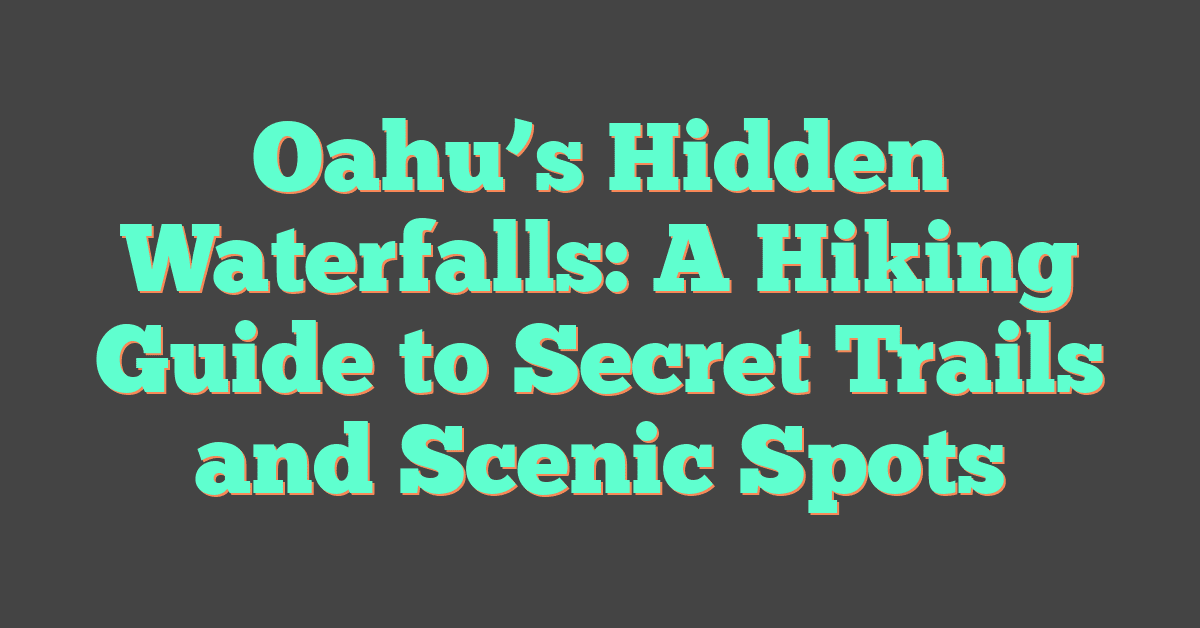Hiking in Oahu, Hawaii always feels like a treat to me. The hidden waterfalls tucked away in the lush forests make the experience even more special.

These spots stay less crowded than the famous beaches. Every visit feels like a real adventure.
If you want to experience natural beauty and peaceful escapes, Oahu’s hidden waterfalls offer some of the best hiking highlights on the island.

I want to share my favorite waterfall hikes in Oahu. These range from quiet jungle trails to tall falls you can hear before you see.
Whether you’re new to hiking or just want something different from the usual tourist stops, there’s a trail for you. I’ll guide you to lesser-known places like Likeke Falls and suggest tours that help keep hikes safe and fun, such as this Oahu hidden waterfall hike.
Planning Your Oahu Waterfall Adventure
I always plan ahead before heading out for a waterfall hike in Oahu. Timing my visit, packing well, and staying safe make each hike more fun and less stressful.
Best Time to Visit
I find that spring and early summer, from April to early July, are the best months for a waterfall hike in Oahu. The weather stays mostly sunny, trails are drier, and waterfalls flow steadily from winter rains.
I avoid hiking after heavy rainstorms because trails get muddy and slippery. Going early in the morning helps me avoid crowds and enjoy the quiet sounds of nature.
Midday often feels hot, especially on exposed trails, so I wear light clothes and a hat. Holiday weekends get busy, so I pick weekdays for a more peaceful hike.
I always check trail conditions online before I go.
Essential Gear and Supplies
Packing the right gear keeps me comfortable and safe. For every Oahu waterfall hike, I wear sturdy shoes with good grip because many paths are muddy or rocky.
I bring a lightweight rain jacket since rain can come without warning. My backpack always has these items:
- Water (at least 1-2 liters)
- Snacks like trail mix or granola bars
- Mosquito repellent (spray or wipes)
- Sunscreen and a hat
- Small first aid kit for cuts or blisters
- Towel or small cloth for wet or muddy feet
- Trash bag to carry out my garbage
I use a waterproof pouch for my phone and anything I want to keep dry.
Staying Safe on the Trails
I always keep safety in mind when hiking to Oahu’s hidden waterfalls. Trails can be slippery with rocks and tree roots, so I take my time and watch my step, especially near water.
Hiking with a friend helps. If I go alone, I tell someone my plans and when I expect to return.
I follow trail signs and avoid shortcuts, even if they look easier. I never swim in pools under waterfalls after heavy rain because flash floods can happen.
Checking the local weather forecast and trail updates online helps me avoid unexpected dangers. I pack mosquito repellent and wear long sleeves to avoid bites, especially in thick rainforest.
I take rest breaks, drink water, and snack often to keep my energy up. For more tips, I read about guided hikes on Oahu at Adventure In Hawaii’s waterfall hiking tours.
Top Hidden Waterfalls on Oahu
Some waterfalls in Oahu stay tucked away from the crowds. You usually need to hike through scenic forests to reach them, but the peaceful views are worth it.
Lulumahu Falls
Lulumahu Falls stands out as one of Oahu’s best-kept secrets. This waterfall is about 50 feet tall and pours into a rocky pool surrounded by bamboo and lush greenery.
The trail isn’t marked with big signs, so fewer people visit. To reach the falls, I hike a 2-mile round trip through old stone ruins and thick woods.
The path sometimes gets muddy, so sturdy shoes help.
Key Details:
- Distance: 2 miles round-trip
- Level: Moderate, a bit slippery
- Permit: Sometimes needed for access
It’s best to bring water and a camera because the falls look especially pretty after rain.
Maunawili Falls
Maunawili Falls has a jungle feel with tall trees and hanging vines. The trail is about 3 miles round-trip, and I cross streams and roots along the way.
The waterfall drops about 20 feet into a pool good for swimming. Some people jump from the rocks, but I always check the water depth first.
Highlights:
- Trail length: 3 miles
- Features: Stream crossings, muddy areas
- Swimming: Yes, but look out for slippery rocks
On weekday mornings, the trail feels much quieter.
Waimano Falls
When I want a challenge, I hike to Waimano Falls. The steep trail is about 2.8 miles round-trip and winds through lush vegetation.
The hike ends with a small set of waterfalls and natural pools. Fewer people visit because the return hike is steep.
The pools are nice for wading, and ropes hang from trees for swinging into the water.
Quick Facts:
- Trail length: 2.8 miles
- Best for: Adventurous hikers, rope swings
- Traffic: Lower than other trails
I wear shoes with good grip and bring snacks since the climb back can be tiring.
Jackass Ginger Pool
Jackass Ginger Pool sits in Nu‘uanu Valley, hidden in a forest filled with ginger plants. The trail is about a mile round-trip and is easy for families.
The waterfall forms a calm pool at the bottom. Locals named it “Jackass Ginger” after the wild ginger plants growing nearby.
The area is popular for picnics and is a favorite spot for a quick dip on hot days.
Essentials:
- Distance: 1 mile round-trip
- Swimming: Calm pool, small cascade
- Family Friendly: Yes
I like to pack a lunch and relax here, surrounded by quiet woods and the sound of the falls.
Popular Waterfalls Worth the Hike
Some waterfall hikes on Oahu are easy to reach, while others are more challenging or even restricted. These hikes let you see lush scenery and flowing water up close.
Manoa Falls
Manoa Falls is one of my favorite places to visit on Oahu. The waterfall sits in a tropical rainforest just a short drive from Honolulu.
The hike to the falls is about 1.6 miles round trip and usually takes 1 to 2 hours. The trail is well marked and not too steep, so families and beginners can enjoy it.
At the end, a 150-foot waterfall waits, surrounded by dense greenery. The area can get muddy, so I wear sturdy shoes and bring extra socks.
Swimming is not allowed because of Leptospirosis risk, but the view is worth the walk. Parking is available near the trailhead, but weekends can be crowded.
Sacred Falls (Restricted Access)
Sacred Falls is known as one of Oahu’s most beautiful spots. It’s a tall, narrow waterfall in a remote valley.
The trail has been closed since 1999 after a deadly landslide, so visiting on foot is not legal or safe. Park rangers patrol the area, and entering can mean a big fine.
Native Hawaiians consider the area sacred. The best way to see Sacred Falls is by helicopter tour.
This way, I can enjoy the amazing views while staying safe and following the rules. You can read more about Sacred Falls’ restricted status at this local discussion.
Navigating Oahu’s Waterfall Trails

Planning ahead makes hiking days in Oahu much smoother. Knowing where to park and how to access the trails saves time and avoids frustration.
Popular routes near the Pali Highway need extra attention to detail.
Trail Access and Parking Tips
Getting to waterfall trails on Oahu isn’t always simple. Some trails have limited parking that fills up early, especially on weekends.
I try to arrive at sunrise or before 9:00 AM to get a spot. I look for official parking areas and posted signs.
Many trailheads border neighborhoods, so I respect local homes and avoid blocking driveways. If I see “no parking” signs, I move my car to avoid tickets.
Some trails, like Manoa Falls Trail and Waimea Valley, offer paid parking lots with attendants. I bring a small fee just in case.
Here’s a quick table to remember parking options:
| Trail Name | Parking Type |
|---|---|
| Manoa Falls | Paid Lot |
| Maunawili Falls | Street/Neighborhood |
| Waimea Valley | Paid Lot |
| Lulumahu Falls | Street/Restricted |
I always double-check if trails are open before heading out. Some, like Sacred Falls, have been closed for years due to safety reasons (see details here), and it’s illegal to enter.
Using the Pali Highway
The Pali Highway connects Honolulu to the windward side of Oahu. I use it when I hike in the Koʻolau mountains or visit waterfalls on the eastern side of the island.
Many hidden waterfall trailheads sit a short drive from the main highway. I find signs for landmarks like the Pali Lookout, which has parking for quick scenic stops.
Traffic gets heavy around rush hour, so I plan my drive for late morning or early afternoon. The highway is well maintained, but sudden weather changes are common.
Mist, wind, and rain often appear in the mountains. I keep rain gear handy and check for weather warnings before I go.
Some hiking and island tour companies use the Pali route for their guided adventures. I watch for shuttle buses and group tours that use trail parking lots at popular spots.
Experiencing Oahu’s Lush Rainforests
I love hiking through Oahu’s rainforests. I hear the gentle sound of water and see tall trees all around.
From rare birds to clear pools at the base of hidden falls, each step brings something surprising and beautiful.
Wildlife and Plant Life
When I walk through these rainforests, I see giant ferns and towering bamboo. Wild orchids and colorful hibiscus flowers sometimes line the path.
Bright green moss covers rocks near streams. Birds fly all around me.
If I look up, I might spot the ‘apapane or hear the call of a white-rumped shama echoing between the trees. Insects buzz softly, and sometimes a mongoose scampers across the trail.
I watch my step because the forest floor is home to tiny lizards and sometimes even a Hawaiian tree snail. Many plants here grow only on these islands and thrive in the wet, shady climate.
The air smells fresh with earth and flowers.
Best Spots for Swimming
Some of my favorite moments happen when I find a perfect spot to swim beneath a waterfall. The Manoa Falls Trail has a 150-foot waterfall, with water rushing down a mossy cliff.
The pool at the base feels cool, and the setting is peaceful, surrounded by thick green jungle. Other trails lead to small, clear pools where I dip my feet or take a swim, like at Waimea Valley or on lesser-known paths.
I always put safety first. After heavy rain, I avoid swimming because water can move fast and get deeper.
On calm days, these spots are perfect for cooling off during a hike. Some pools have rocks to sit on, and the water is often so clear I can see the smooth stones at the bottom.
Cultural and Historic Sights Along Waterfall Hikes

When I hike in Oahu, I see more than waterfalls. I also find places where history and culture come alive.
Some waterfall trails are close to ancient ruins and sites tied to Hawaiian royalty.
Kaniakapupu Ruins
As I walk through the forest, I sometimes come across the old Kaniakapupu Ruins. These mossy stones are what remain of King Kamehameha III’s summer home.
The ruins sit quietly among bamboo trees. The path to reach them is short and shady.
Kaniakapupu means “the singing of the land shells.” This spot once welcomed royal guests and hosted large feasts and important meetings.
I see old stones stacked in low walls and imagine what it looked like during the king’s day. I always remember that this area is fragile and meaningful for the Hawaiian people.
Visitors must stay silent and respectful. I never touch or move anything.
Today, people discourage or even forbid visiting to protect the site. If I walk by, I do so quietly from a distance and leave no trace.
Legacy of King Kamehameha III
King Kamehameha III ruled Hawaii longer than any other monarch. He worked to unite the islands.
He often visited the mountains to cool off and plan for the future. I still feel his legacy when I pass by places like Kaniakapupu and nearby waterfall trails.
He introduced Hawaii’s first Constitution. His leadership brought many changes that shaped the islands.
He honored both Hawaiian culture and new ideas from abroad. Many hiking guides mention him by name.
Markers and stories about him appear near historic trails. His time as king connects with the land, the rain, and the waterfalls of Oahu.
When I visit these sights, I try to picture him walking through the rainforest. I imagine him surrounded by the sound of water and the soft green light coming through the trees.




